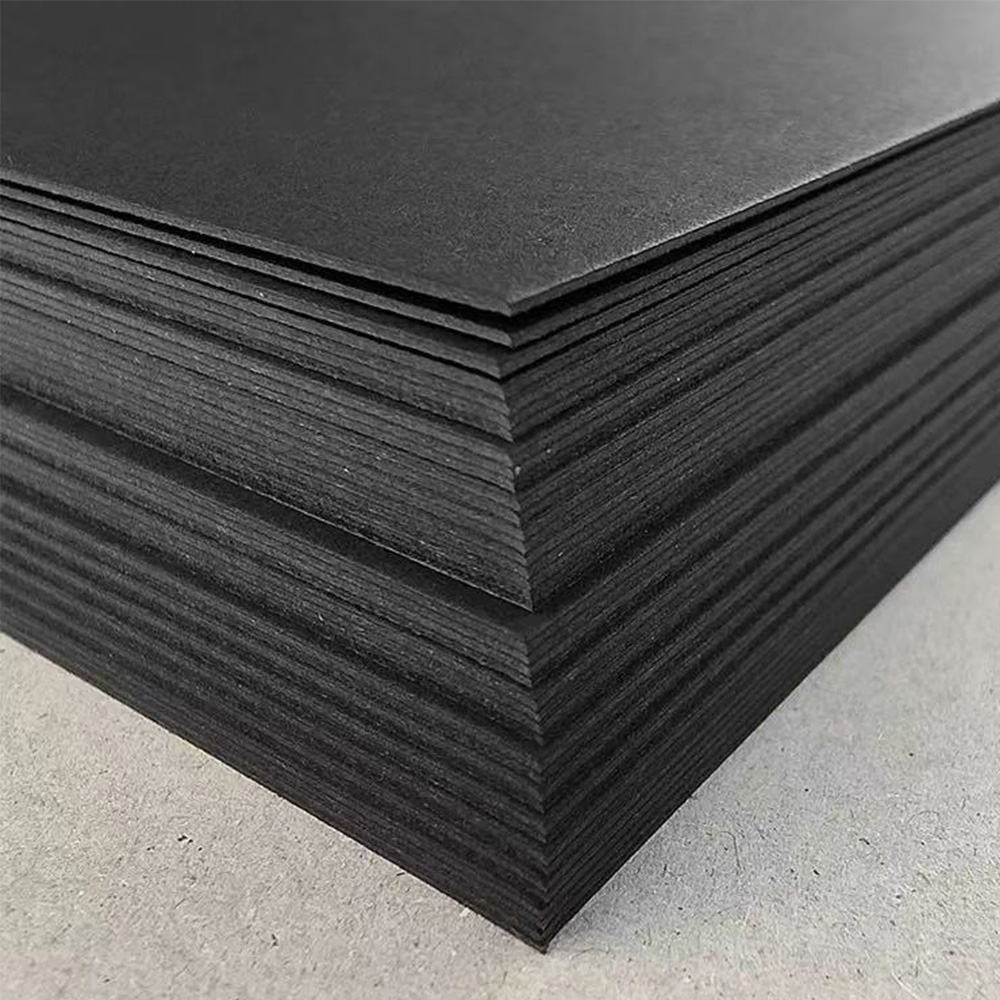Black Card Paper (Black Card) is a high-density, deep-black specialty paper known for its luxurious texture, excellent opacity, and bold visual impact.
It is widely used in premium packaging, brand materials, gift boxes, hang tags, business cards, invitations, and presentation covers.
Unlike ordinary white card stock printed with black ink, true black card paper offers richer depth, uniform color through the sheet, and an instantly recognizable sense of elegance, minimalism, and sophistication.
Types and Characteristics
- Solid-core Black (Dyed-through)
This type is dyed black all the way through, not just on the surface. It avoids white edges when cut or die-cut, making it perfect for designs with exposed edges, cutouts, or window details. - Surface-colored Black
Here, the black coating is applied only on the surface. It’s more cost-effective but may reveal a faint white core when trimmed. Best used for non-exposed structures or laminated applications. - Black Kraft Paper / Black Cardboard
Made from kraft pulp, this option has a stronger fiber textureand natural matte finish, ideal for eco-style packaging, shopping bags, and tagsthat require both toughness and texture.
Common Weight Range: 200–400 gsm for cards, sleeves, and covers; 450–700 gsm for rigid packaging and inserts.
Heavier stock increases stiffness and opacity but requires deeper creasing to prevent cracking during folding.
Texture and Visual Qualities
Surface Finishes: Available in smooth matte, linen, sand, leather-grain, or soft-touch textures. Matte finishes feel understated; textured ones add tactile depth.
Color Depth: Premium black card has a deep, true black tone (low L value) that remains rich even under low light.
Anti-fingerprint & Scratch Resistance: Ultra-matte surfaces show marks more easily—choose anti-scratch matte lamination or coated variants for durability.
Sustainability: Many black cards are FSC®-certified, acid-free, lignin-low, and partially recycled—meeting modern eco-friendly packaging standards.
Printing and Finishing Techniques
Because of its dark background, printing on black card paper focuses on contrast and texture rather than full-color images.
Common and effective methods include:
Hot Foil Stamping: Gold, silver, or colored foils create sharp, luxurious contrast—ideal for logos or decorative lines.
White Ink Printing: Digital or screen-printed white underlay enhances color vibrancy and readability.
Pantone Spot Colors: Metallic or bright hues stand out beautifully; pastel tones require a white base.
Spot UV or Raised UV: Glossy contrast against a matte black base for subtle highlights.
Embossing / Debossing: Adds tactile relief and depth for logos or patterns.
Laser Cutting / Die-cut Windows: Works best with solid-core black boards for clean, crisp edges.
Lamination / Varnish: Matte or soft-touch finishes add protection and a refined feel.
Binding & Adhesion: Use strong adhesive and pre-crease folds to prevent cracking or delamination.
Applications
Black card paper’s sophisticated tone makes it suitable for a wide range of premium applications:
Business Cards & VIP Cards: Solid black base with foil or white ink; raised UV adds a tactile touch.
Hang Tags & Fashion Accessories: Black kraft or textured paper with metallic foil or screen-printed logo.
Gift Box Inserts & Dividers: Thick dyed-through boards with clean cut edges and minimalist print.
Paper Bags & Sleeves: Black kraft with reinforced folds and cotton or ribbon handles.
Invitations, Certificates, and Covers: Black card with white ink printing and foil details for contrast and drama.
Production & Handling Tips
Color Consistency: Always confirm with physical swatches or test prints—black intensity varies between mills and batches.
Fine Text & Lines: Keep minimum stroke width around 0.2–0.3 mm for white ink or foil accuracy.
Drying & Durability: Black card absorbs less ink; allow longer drying time or apply protective coating.
Creasing & Folding: Use deep scoring tools and controlled pressure to avoid cracking along folds.
Storage: Keep flat, dry, and away from direct sunlight; allow time to acclimate humidity before production to prevent curling.
Cost Considerations
The cost of black card packaging depends on:
Type of paper (solid-core vs. surface-colored vs. kraft).
Basis weight (gsm) and paper brand.
Finishing processes (foil, white ink, embossing, UV, lamination).
Product structure and shape (die-cut, folding, glued or rigid).
Quantity — setup and calibration costs are higher for black substrates.
